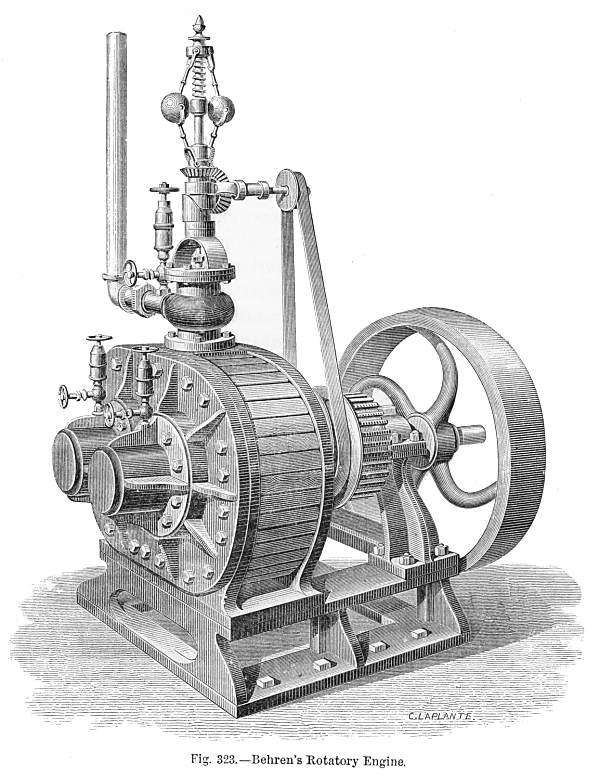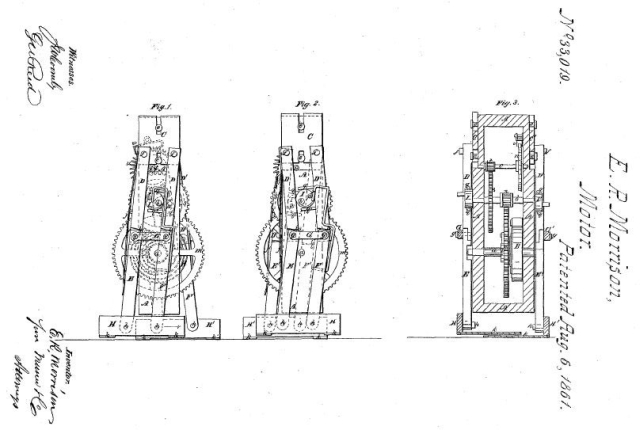
This wood and brass model with clockwork by Enoch Rice Morrison is a walking mechanism probably very similar to his “Steam Man”. The maker’s name is painted on an upright as is his home town – Bergen, NJ The model is 6.5″ tall. I have now located the patent for this mechanism – see below.
Tuapeka Times, Volume III, Issue 134, 1 September 1870, Page 7.
GENERAL NEWS.
There is now on exhibition in New York a ” steam man ” which actually walks — not merely performs with the legs the movements necessary for walking, while the body is suspended on a fixed support like the old ” steam man” which made so much noise about two years ago [RH – Dederick 1868], and which, we suppose, is now defunct. It was claimed for the old steam man that it was to be used for traction and other useful purposes ; but the new one commences its career with no such pretensions. All that is claimed for it is that it makes an interesting exhibition. It has the same walking mechanism as the clockwork walking dolls patented some years ago [CZ: Morrison’s 1861 “Locomotive Apparatus”, not the 1862 “Autoperipatetikos”]. The mechanism is driven by one of Behren’s rotary steam engines, which has been found better suited than any reciprocating engine on account of its producing less vibration, and consequently being less liable to disturb the equilibrium of the man in the walking movement. As an ingenious piece of mechanism, the walking steam man is an object of interest.
KokomoTribune 02 June,1870 p.1
(uncorrected text – basically an extract from an 1870 Scientific American , not to be confused with the later Prof. Moore Sci Am article)
(Note: RH -Â walks stand-alone due to cross-bars on its feet)
The Steam Man.
Have we not heard somewhere in Song of a wonderful steam arm which hammered away all obstacles and of a steam leg that walked the owner to death and walked away with his ghost. If our memory serves us, we have. We never expected to meet those wonderful members in the flesh but no man knows today what is reserved for him tomorrow. We have lived to see steam legs, steam arms, steam body and breeches, steam coat, hat and choker, all combined to eclipse all that poets have sung or dreamed.
Passing up Broadway we saw large Posters announcing the greatest wonder of any age, past, present, or future, which wonder was explained, In smaller letters, to be an imitation of the human form divine, impelled by steam, and approximating in agility the renowned Hanlon Brothers [famous acrobats of the time]. We paused, considered, entered the place of exhibition, and found the steam man in a perfectly nude state, with the exception of his hat.
His other articles of dress hung upon …. … ..    them the perspiration they had absorbed in his severe exercise. We were at fault, however in this supposition, as we were told by the steam gentleman’s valet, who was giving his master a drink of benzene through a hole in his shoulder This attendant told us that the grace of the steam man’s movement, and the comeliness of his features had begotten a general desire in the minds of his admirers to see his manly proportions, and his modesty offering no protest he was accordingly disrobed for the benefit of the public.
We proceeded to take observations of his anatomy from drivers points of view. The gluteal region, kindly protected from rude assaults of hostile boots in ordinary mortals, by thicker muscles than are found on other parts of the frame, was replaced on the steam man by a Behrens rotary engine, the custom of which we’d give, we may imagine, an outline — when covered by clothing —not, unlike that demanded to sustain the resemblance to a man so far as this important portion of the human system is concerned.
This engine propels a screw, which actuates worm gears; the gears acting eccentrics, which actuate the legs and feet, which actuate the entire man at a velocity of, we should say, about forty feet per minute, when doing his level best.
His legs are merely straight bars, With large blocks of iron as feet, fastened rigidly to the legs. The legs are joined to the feet at the middle.
So that the heels are as long as the front part of the foot; and to keep the figure from toppling over side-wise, a flat bar extends laterally from each foot.
To give the appearance of bending at the knee a toggle joint is attached to the front part of each leg, but this has nothing to do with the propulsion of the automaton [RH: This comment also mentioned in the 1861 patent].
There is nothing in the movement analogous to that of the human leg. One foot is raised and then advanced, the whole leg moving forward, not swinging, with the foot, each foot being alternately the pedestal or base upon which the body rests.
The fuel employed is some fluid hydrocarbon, and the boiler is concealed in the body. The smoke escapes through a hole in the crown of the hat. When the steam man is about to take a walk, his valet takes a pair of pinchers and after opening the throttle valve, seizes with the pinchers the end of a shaft which protrudes just below the abdomen, and giving it a partial turn, a most remarkable sound resembling the rumbling of wind in the bowels commences, and the steam man sets out upon his travels with a rather unsteady gait, and with extremely short steps. When he reaches the end of his limit the steam is shut off, and he is turned about face by his faithful attendant, and retraces his steps in the same manner as we have described.
On the whole, the steam man, is a curios automaton, and much more satisfactory than his predecessor exhibited two or three years since in this city, who could only stand upon fixed crutches and kick like a punky child suffering for a spanking.Â
It is interesting to note the reference to the Hanlon Brothers as Morrison’s 1861 walking mechanism patent was actually assigned to them!.
Morrison’s Steam Man utilised the Behren’s rotary steam engine. Â
Here is a picture of a rather large Behren’s Rotary Steam Engine. See site here for more information plus an animation on how it works:

There is a possibility that Rowe’s first Steam Man is the same or similar to Morrison’s Steam Man, and may be linked to Prof. George Moore’s Steam Man.. Â
The video clip below shows the “Autoperipatetikos” doll in motion. Note that only one of its legs appears to be operational. Â
Morrison’s patent for “Autoperipatetikos” – (Walking Doll)
IMPROVEMENT IN AUTOMATIC APPARATUS FOR WALKING FIGURES -Â Â ENOCH R.. MORRISON
Patent number: 35886
Issue date: 1862
See full patent document here.
Morrison’s 1861 patent for “Locomotive Apparatus” . Notice it was assigned to the Hanlon Brothers, who get mentioned in the Scientific Americal article on this Steam Man. It has been generally acknowledged that the “Autoperipatetikos” walking doll was the first walking toy, but if the Hanlon Brothers did produce toys based on Morrison’s design, Morrison may still have the recognition of having the first patented toy walking mechanism, but realised on his earlier patent, not the later “Autoperipatetikos” patent.

Inventor: E. K. MOKEISON [Google OCR error – should be “Enoch Rice Morrison”]
Assignee: THE HANLON BROTHERS
Patent number: 33019
Issue date: Aug 6, 1861
Enoch Rice Morrison was residing in South Bergen , New Jersey at this time.
See full patent document here.
Note: 30 July 2010. Both the above patents have not appeared on the internet before. They are not found under the normal search criteria using Google patent search, either, and are the results of many tens of hours of indivdual patent searching, such is what I do for some of my researched postings. Enjoy!